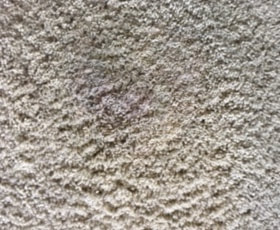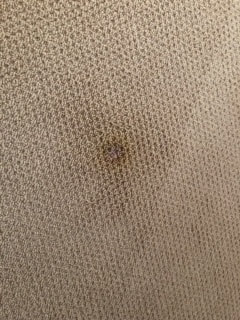When doing a search on the internet for correcting bleach spots, most of the methods will not give good results. Carpet color restoration should never be viewed as a "Trial and error". You want to know for a surety about what you are doing. You should never guess. The look and feel should be exactly the same as the surrounding.
It is interesting that the first sites usually to come up when doing a search often contain the greatest miss-information. Applying a mild dish soap and rubbing the carpet with a towel or sponge is suggested on many of these sites. Their claim is that the stain will gradually disappear. Dish soap will actually remove more color, while Rubbing will distort the fibers. Both of these suggestions may prevent an exact match when using carpet mill dye later on. They do not work and the stain will not gradually disappear. These sites are deceptive with the end goal of having the individual contact the promoter.
Adding white vinager will not restore the color. When color is missing on a bleach spot, the missing dye must be replaced with the same dye that was originally there. This would be carpet mill dye. The use of any other form of dye is not acceptable.
The dyes used in crayons is another wrong method that frequently comes up when doing a search on the internet. Applying crayons puts a waxy coat on the surface of the carpet fibers. This would not replace missing carpet dyes as the wax usually prevents dye from entering the dye sites within the fibers. The danger here is when the dye from the crayon does enter the dye sites. This can happen when the carpets are cleaned or when heat is applied. Most bleach spots lose only partial color. Adding a matched color will join with the remaining color resulting in the wrong shade or color of the repaired area. This complicates matters as the repaired area looks worse than original stain. The wrong shade or color must be removed prior to using the correct method. The wax from the crayons may also block the dye sites from receiving carpet mill dye. It is much easier to use the correct method in the first place.
It is interesting that the first sites usually to come up when doing a search often contain the greatest miss-information. Applying a mild dish soap and rubbing the carpet with a towel or sponge is suggested on many of these sites. Their claim is that the stain will gradually disappear. Dish soap will actually remove more color, while Rubbing will distort the fibers. Both of these suggestions may prevent an exact match when using carpet mill dye later on. They do not work and the stain will not gradually disappear. These sites are deceptive with the end goal of having the individual contact the promoter.
Adding white vinager will not restore the color. When color is missing on a bleach spot, the missing dye must be replaced with the same dye that was originally there. This would be carpet mill dye. The use of any other form of dye is not acceptable.
The dyes used in crayons is another wrong method that frequently comes up when doing a search on the internet. Applying crayons puts a waxy coat on the surface of the carpet fibers. This would not replace missing carpet dyes as the wax usually prevents dye from entering the dye sites within the fibers. The danger here is when the dye from the crayon does enter the dye sites. This can happen when the carpets are cleaned or when heat is applied. Most bleach spots lose only partial color. Adding a matched color will join with the remaining color resulting in the wrong shade or color of the repaired area. This complicates matters as the repaired area looks worse than original stain. The wrong shade or color must be removed prior to using the correct method. The wax from the crayons may also block the dye sites from receiving carpet mill dye. It is much easier to use the correct method in the first place.
Using hair dye for bleached carpeting is at the top of wrong methods not to use. The result is usually a dark looking stain that is difficult to remove. The hair dye actually binds with with the carpet dye sites creating a permanent stain. The difficulty now is in removing this dark stain. Partial color from the hair dye remains after bleaching the stain. Yellow is the remaining color. This yellow creates a wrong shade when using the correct method.
Common sense would tell you not to use the following: Acrylic Paint, Automotive Carpet Paint, Interior House Paint, ink, sharpies.
All of these will make a simple repair using the correct method difficult. Do not clip or Cut the Stain Out! Teabags and coffee have no place in color correcting color loss on a carpet.
All of these will make a simple repair using the correct method difficult. Do not clip or Cut the Stain Out! Teabags and coffee have no place in color correcting color loss on a carpet.




